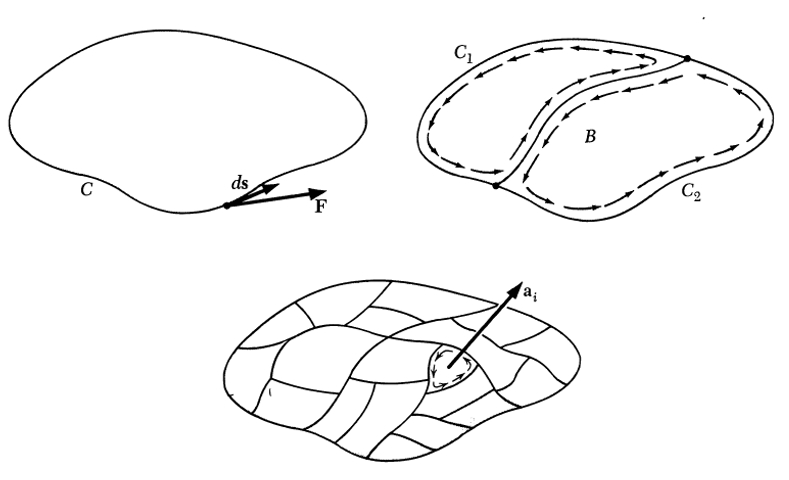Electric field rotor
Storyboard
The electric field rotor seeks to detect if there is circulation in it. Circulation would mean that closed field lines existed, that without existing charges in space they close on themselves. A particle in that field would make a closed path without escaping or falling on or to any load. For the static case it is shown that there is no such circulation and that all field lines start and end in loads.
ID:(1569, 0)
Circulation
Image
Cuando se estableció el potencial eléctrico se trabajo con la idea de caminos entre dos puntos que en el caso de ser serrados eran nulos:
| $ \Delta\varphi = -\displaystyle\int_C \vec{E}\cdot d\vec{s} $ |
Dichos caminos se pueden segmentar en caminos mas pequeños:

ID:(11569, 0)
Definition of the electric field circulation
Equation
En base al integral a lo largo de un camino se puede definir la circulación como
| $ \Gamma = \displaystyle\int_C \vec{E}\cdot d\vec{s}$ |
ID:(11570, 0)
Decomposition of partial circulations
Equation
Una circulación general
| $ \Gamma = \displaystyle\int_C \vec{E}\cdot d\vec{s}$ |
puede ser descompuesta en circulaciones menores
| $\displaystyle\int_C \vec{E}\cdot d\vec{s} = \displaystyle\sum_i \displaystyle\int_{C_i} \vec{E}\cdot d\vec{s}_i$ |
ID:(11571, 0)
Rotor definition
Equation
Análogo a la definición de la divergencia
| $\nabla\cdot\vec{E} = \lim_{V_i\rightarrow 0} \displaystyle\frac{1}{V_i}\displaystyle\int_{S_i} \vec{E}\cdot d\vec{S}_i$ |
se puede definir como el rotor la circulación por área en la dirección de la normal a la superficie
| $ (\nabla\times\vec{E})\cdot\hat{n} = \lim_{S_i\rightarrow 0}\displaystyle\frac{1}{ S_i }\displaystyle\int_{C_i}\vec{E}\cdot d\vec{s}$ |
ID:(11572, 0)
Stokes' theorem
Equation
Con la definición del rotor
| $ (\nabla\times\vec{E})\cdot\hat{n} = \lim_{S_i\rightarrow 0}\displaystyle\frac{1}{ S_i }\displaystyle\int_{C_i}\vec{E}\cdot d\vec{s}$ |
se tiene que la suma sobre las superficies es
abla\times\vec{E})\cdot d\vec{S}=\displaystyle\int_S (
abla\times\vec{E})\cdot d\vec{S}
que corresponde al teorema de Stokes
| $ \displaystyle\int_C \vec{E} \cdot d\vec{s} =\displaystyle\int_S (\nabla\times\vec{E} )\cdot d\vec{S} $ |
ID:(11573, 0)
Electric field circulation
Equation
As the circulation on a closed road is null
| $ \displaystyle\oint_C \vec{E}\cdot d\vec{s}=0$ |
Stokes' theorem
| $ \displaystyle\int_C \vec{E} \cdot d\vec{s} =\displaystyle\int_S (\nabla\times\vec{E} )\cdot d\vec{S} $ |
implies that
| $ \nabla\times\vec{E} = 0 $ |
This means that in the case of electrostatics the electric field has no circulation, that is, its lines do not form closed circles without touching charges.
ID:(11574, 0)
